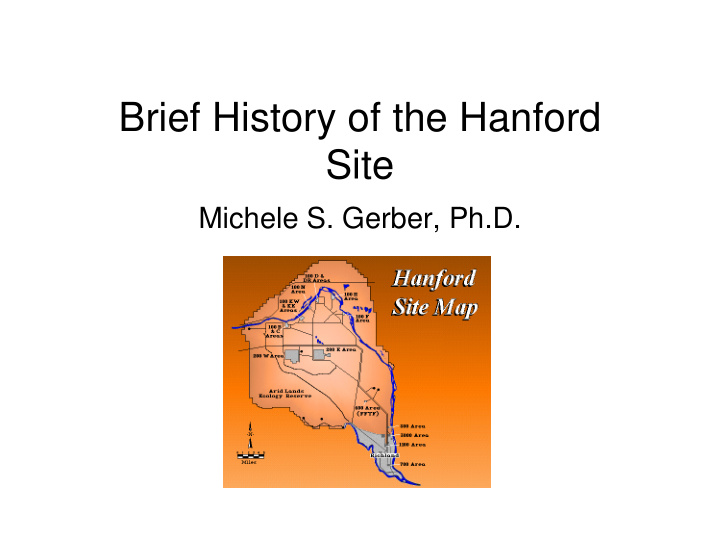



Brief History of the Hanford Site Michele S. Gerber, Ph.D.
Founding • Acquired February 1943 – 640 square miles in southeast Washington – Conditions perfect for Manhattan Engineer District requirements • Construction began March 1943 – Army Corps of Engineers and DuPont
Original Mission • Produce plutonium for world’s first atomic weapons • Mission succeeded – Trinity bomb test (July 1945) – Nagasaki weapon (August 1945)
World War II Operations • 29 months from beginning of construction to WWII Victory (March 1943-August 1945) • Huge construction and operations accomplishments – Complete fuel fabrication facilities – First three full-size reactors in world – First two full-size radiochemical separations plants – Plutonium isolation facility – 64 single-shell tanks for waste storage – Site infrastructure (i.e.roads, communications, electrical, water) for self-contained operations – Construction camp housing and feeding 51,000 workers – City of Richland built up from capacity for 300 to 17,000 people
The Hanford Process
The Hanford Process, con’t
WWII Tank Farm under construction, 1944
Early Postwar Developments • 1946 – Production lull and period of indecision • Hanford Site employment fell by half (10,000 to 5,000 operations workers) – Atomic Energy Act of 1946: AEC created – Winston Churchill’s Iron Curtain Speech • 1947: AEC ordered huge expansion
First Postwar Expansion • Largest peacetime construction project in American history to that point – Cost more than original Hanford construction – Two more reactors built – Plutonium Finishing Plant – 42 additional waste storage tanks – Expansion of Richland to 23,000 – Construction of trailer/barracks enclave for construction workers
Plutonium Finishing Plant new in 1949
Plutonium “button” or “puck”
Cold War Escalates • 1949 - Soviets explode 1 st atomic bomb – Mao Tse-tung’s Communist Forces victorious over Nationalist forces in China – NATO (North Atlantic Treaty Organization) formed • 1950 – President Truman decides to pursue development of H-bomb – Korean War begins (June) – Communist Chinese enter Korean conflict (December) • 1952 (U.S.) and 1953 (U.S.S.R.) explode hydrogen bombs
Second Postwar Expansion (Korean War Expansion) • REDOX Plant • C Reactor • 2 evaporators for tank waste • 18 additional waste tanks • Major 300 Area laboratories expansion • U Plant activated and UO3 Plant constructed
Hanford’s 2 nd Postwar Expansion: C Reactor under construction, 1951
TX Tank Farm under construction, 1949
Cold War Escalates Further • 1952 – Dwight D. Eisenhower elected president – Policy of massive retaliation • Deterrent value of large defense production facilities • Purposefully leaked information about new facilities • 1955 – Nikita Khrushchev comes to power in Soviet Union
Third Postwar Expansion (Second Korean War Expansion) • President Eisenhower’s Program X – KE and KW Reactors built – PUREX Plant – Plutonium recycle facilities – 21 additional waste tanks
K West Reactor under construction, 1954
Hanford’s Peak Production Years • 1955-1960 – All 8 single-pass reactors undergo “Modifications for Increased Production” – Reactor power levels soar • 1956 – PUREX begins operations – WWII processing plants close – Production capacity quadruples in 4 years – REDOX relegated to “special operations” – PUREX becomes Hanford’s workhorse • 1957 – N Reactor construction authorized in response to Sputnik
President John F. Kennedy dedicates N Reactor 9/23/63
Hanford Cut-Backs 1960s, 1970s • All 8 single-pass reactors close between 1964 and 1971 • N Reactor closes briefly in 1971 – Re-opens for electric power production only • Fabrication work ends at PFP, 1965 • Plutonium Reclamation Facility closes 1978-1984 • PUREX closes 1972-1983
Production Cutbacks: Experiments with Non-Defense Work • PFP’s defense production lines make special oxides for power reactor experiments • Special radioisotopes extracted for NASA and other programs • N Reactor operates for power production only • Fast Flux Test Facility built as largest national experimental facility for power reactor technology • 28 double-shelled waste tanks built
FFTF dedication, 1980
Hanford Production Facilities Reactivated • PUREX retrofitted with multiple environmental upgrades, and oxide conversion facilities • N Reactor re-tooled to produce weapons-grade material • PFP and PRF upgraded; reopen for defense material production 1983 and 1984
Cold War Ends
Solid Waste Trench, Hanford, 1953
K East Reactor basins overflowing, leaking, 1962
Waste Cleanup Project: Largest in the World • Hanford’s Tri-Party Agreement (TPA-Federal Facility Agreement and Consent Order) – U.S. DOE, U.S. EPA, Washington State Department of Ecology – May 1989 – Revised many times; living document • Hanford cleanup funded at nearly $2B per year
First MCO leaves KW Basin 12/07/2000
Vitrification Plant, August 2007
Preserving our History
Recommend
More recommend